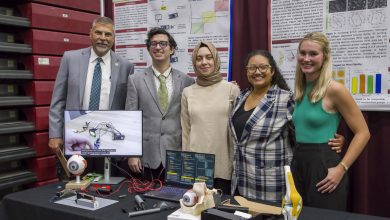How Human Centered Design Benefits the World
Human centered design is a way of approaching the design and management of products that takes into consideration the user’s perspective and needs. The process has several steps including observation of problems within context, brainstorming, conceptualizing, developing, and implementing the solution.
A Florida Tech degree in human centered design can jump-start this world-changing career

When human centered design is used, the designs are more effective and satisfying for the users and there are fewer adverse effects, accidents, and user injuries than with traditional types of design. Human centered design typically involves technology, which is used to improve the end result for the user.
Starting With Observation
Human centered design always begins with participatory action research into current products and the problems that typically exist there. Researchers observe product users in the real world or in real-world situations, and users are often asked for their ideas on how to solve problems.
Immersion and contextual framing help product developers get a true sense of users’ needs and difficulties so that they can address these challenges in their development of new products.
Applying Findings to Product Development
Once the observation stage has had time to develop fully and brainstorming has taken place, designers can go on to building models and prototypes of products, which may then be tested by users before widespread implementation.
Once a product is developed, system usability scales and other feedback help to evaluate the end product to make sure it is an effective solution to the original problem or problems expressed. It is possible that the process will start again to continually improve on each level of products, such as the updates made to each new Apple iPhone that is released, which aim to make it more effective and user-friendly than before.

Benefits of Human Centered Design
Companies that use human centered design tend to have happier customers, which will help the bottom line (as long as they haven’t spent too much money on research, of course). They may also save money on technical support when products are more user-friendly and intuitive.
The benefits go way beyond increasing company profits, however. Human centered design can make users more productive, accessible for more people, and even reduce the stress that can often result from products that are hard to use and understand.
People will have more dignity and care when products are designed well, and these products can set an example that can raise the bar for future interactions to be positive rather than negative. Human centered design is often more sustainable for the environment as well, since user feedback usually indicates that this is important to at least some users.
Human centered design often involves out-of-the-box thinking that leads to creative solutions that wouldn’t come about through traditional design methods. This ends up increasing the quality and usefulness of products throughout the industry when an innovation becomes the standard for products that come after.
Florida Tech offers a Master’s degree in human centered design that helps students pick an area in which to specialize and gives them practical experience in the human centered design process with access to state-of-the-art equipment and laboratory environments for research and development of their own ideas. Learn more about our human-centered design program today!
%CODE1%





